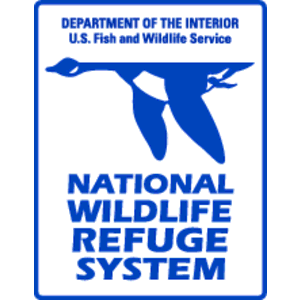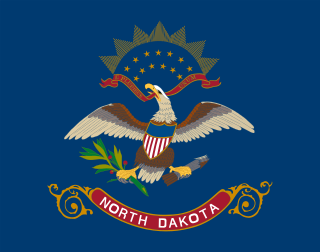
Rolette County is a county located in the U.S. state of North Dakota. As of the 2010 census, the population was 13,937. Its county seat is Rolla. The county was created by the 1872-73 territorial legislature and named for Joseph Rolette, Jr., a fur trader and politician from Pembina. The county government was first organized on October 14, 1884. Before becoming Rolla, the county seat was Dunseith from 1884 to 1885 and St. John from 1885 to 1889.

McLean County is a county located in the U.S. state of North Dakota. As of the 2010 census, the population was 8,962. Its county seat is Washburn. The county was created by the 1883 territorial legislature and organized on November 1, 1883. It was named for John A. McLean, a prominent citizen and the first mayor of Bismarck, North Dakota.

The Halfway Lake National Wildlife Refuge is located in the U.S. state of North Dakota and consists of 160 acres (0.65 km2.) The refuge is a privately owned easement refuge, managed by the U.S. Fish and Wildlife Service. The refuge is closed to the public and was established to protect habitat for migratory bird species and other animal life. Chase Lake Wetland Management District oversees the refuge, which in turn is a part of the Arrowwood National Wildlife Refuge Complex.

The Sibley Lake National Wildlife Refuge is located in the U.S. state of North Dakota and consists of 1,077 acres (4.35 km2). Sibley Lake is a privately owned easement refuge, managed with by the U.S. Fish and Wildlife Service. The refuge was established to protect habitat for migratory bird species, white-tail deer and other mammals. Valley City Wetland Management District oversees the refuge, which in turn is a part of the Arrowwood National Wildlife Refuge Complex. Sibley Lake is a 525-acre (2.12 km2) fresh water marsh.
The Audubon National Wildlife Refuge Complex is located in the U.S. state of North Dakota and consists of numerous National Wildlife Refuges, all of which are managed by the U.S. Fish and Wildlife Service but most of which are on private property, and are known as Easement refuges. Landowners generally agree to abide by regulations imposed by the U.S. Government. The refuges are located in the central sections of North Dakota. The complex is managed from the Audubon National Wildlife Refuge and includes the following National Wildlife Refuges:

Audubon National Wildlife Refuge is a 14,739-acre (5,965 ha) National Wildlife Refuge in the U.S. state of North Dakota. The refuge is managed by the U.S. Fish and Wildlife Service and is the centerpiece of the Audubon National Wildlife Refuge Complex, which includes numerous other refuges in the region. Originally designated as the Snake Creek National Wildlife Refuge in 1955, the refuge was renamed in 1967 in honor of the artist and naturalist John James Audubon. Most of the refuge area is a lake known as Audubon Lake which is managed by the U.S. Army Corps of Engineers.

Camp Lake National Wildlife Refuge is a 585-acre (237 ha) National Wildlife Refuge (NWR) in the U.S. state of North Dakota. The refuge is an Easement refuge that is entirely on privately owned land, but the landowners and U.S. Government work cooperatively to protect the resources. The U.S. Fish and Wildlife Service oversees Camp Lake NWR from offices at Audubon National Wildlife Refuge.

Lake Otis National Wildlife Refuge is a 320-acre (130 ha) National Wildlife Refuge (NWR) in the U.S. state of North Dakota. The refuge is an Easement refuge that is entirely on privately owned land, but the landowners and U.S. Government work cooperatively to protect the resources. The U.S. Fish and Wildlife Service oversees Lake Otis NWR from offices at Audubon National Wildlife Refuge.

Lake Nettie National Wildlife Refuge is a 3,055-acre (1,236 ha) National Wildlife Refuge (NWR) in the U.S. state of North Dakota. 2,420 acres (980 ha) of the refuge are public while the remaining 635 acres (257 ha) is an easement on privately owned land, but the landowners and U.S. Government work cooperatively to protect the resources. The U.S. Fish and Wildlife Service oversees Lake Nettie NWR from offices at Audubon National Wildlife Refuge.

Hiddenwood National Wildlife Refuge is a 568-acre (230 ha) National Wildlife Refuge (NWR) in the U.S. state of North Dakota. The refuge is an Easement refuge that is entirely on privately owned land, but the landowners and U.S. Government work cooperatively to protect the resources. The U.S. Fish and Wildlife Service oversees Hiddenwood NWR from offices at Audubon National Wildlife Refuge.

Lake Patricia National Wildlife Refuge is an 800-acre (320 ha) National Wildlife Refuge (NWR) in the U.S. state of North Dakota. The refuge is an Easement refuge that is entirely on privately owned land, but the landowners and U.S. Government work cooperatively to protect the resources. The U.S. Fish and Wildlife Service oversees Lake Patricia NWR from offices at Audubon National Wildlife Refuge.

Lost Lake National Wildlife Refuge is a 960-acre (390 ha) National Wildlife Refuge (NWR) in the U.S. state of North Dakota. Lost Lake NWR is an easement refuge and is on privately owned land, but the landowners and U.S. Government work cooperatively to protect the resources. The U.S. Fish and Wildlife Service oversees Lost Lake NWR from offices at Audubon National Wildlife Refuge.

McLean National Wildlife Refuge is a 760-acre (310 ha) National Wildlife Refuge (NWR) in the U.S. state of North Dakota. A little less than half the acreage of McLean NWR is on public lands, while the rest is an easement refuge and is on privately owned land, but the landowners and U.S. Government work cooperatively to protect the resources. The U.S. Fish and Wildlife Service oversees McLean NWR from their offices at Audubon National Wildlife Refuge. Originally called Lake Susie NWR, the name of the refuge was changed to its current title in the 1990s.

Pretty Rock National Wildlife Refuge is an 800-acre (320 ha) National Wildlife Refuge (NWR) in the U.S. state of North Dakota. Pretty Rock NWR is an easement refuge and is on privately owned land, but the landowners and U.S. Government work cooperatively to protect the resources. The U.S. Fish and Wildlife Service oversees Pretty Rock NWR from their offices at Audubon National Wildlife Refuge. This isolated refuge is 10 mi (16 km) south of New Leipzig, North Dakota and has been known as a temporary resting place for migrating whooping cranes. In 2002, six adults and one juvenile crane were spotted on the refuge.

Stewart Lake National Wildlife Refuge is a 2,230-acre (900 ha) National Wildlife Refuge (NWR) in the U.S. state of North Dakota. Almost 1,600 acres (650 ha) of Stewart Lake NWR is an easement refuge and is on privately owned land, but the landowners and U.S. Government work cooperatively to protect the resources. The remaining acreage is on public lands. The U.S. Fish and Wildlife Service oversees Stewart Lake NWR from their offices at Audubon National Wildlife Refuge.

White Lake National Wildlife Refuge is a 1,040-acre (420 ha) National Wildlife Refuge (NWR) in the U.S. state of North Dakota. White Lake NWR is entirely on public land and in a very remote region. The U.S. Fish and Wildlife Service oversees White Lake NWR from their offices at Audubon National Wildlife Refuge.

Sheyenne Lake National Wildlife Refuge is an 800-acre (320 ha) National Wildlife Refuge (NWR) in the U.S. state of North Dakota. Sheyenne Lake NWR is an easement refuge and is on privately owned land, but the landowners and U.S. Government work cooperatively to protect the resources. The U.S. Fish and Wildlife Service oversees Sheyenne NWR from their offices at Audubon National Wildlife Refuge.

Lake Ilo National Wildlife Refuge (NWR) is located in the U.S. state of North Dakota and is managed from Audubon National Wildlife Refuge by the U.S. Fish and Wildlife Service. The refuge consists of Lake Ilo, surrounding wetlands and some upland range, providing habitat for hundreds of species of birds, and numerous fish and mammal species. An average of over 16 inches (40 cm) of precipitation falls annually, supporting a prairie ecosystem.

Lake Zahl National Wildlife Refuge is a 3,823-acre (1,547 ha) National Wildlife Refuge in Williams County in the U.S. state of North Dakota. The refuge consists of Lake Zahl which provides habitat for many species of waterfowl and other species. It is managed by the Crosby Wetland Management District.









